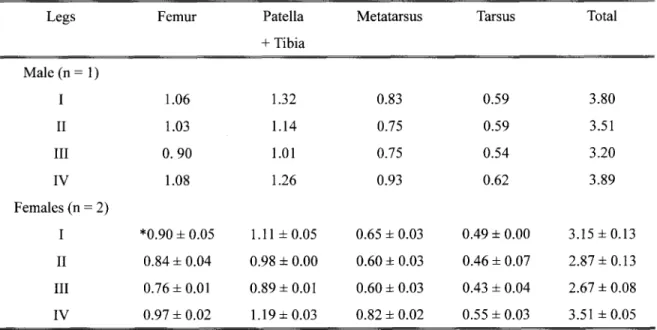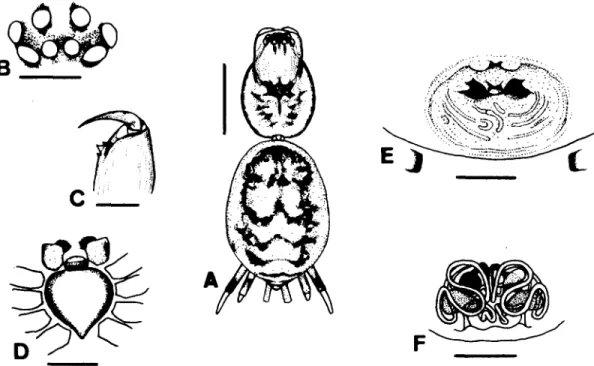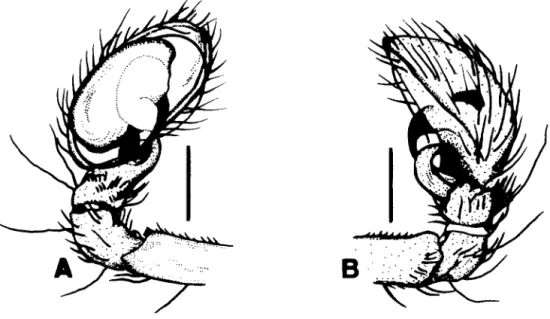Journal ofTaiwan Normal University: Mathematics, Science & Technology 2003,48(1,2), 25-32
A Newly Recorded Spider
of the Family Hahniidae (Arachnida
,
Araneae) 企om
Taiwan
IShyh-Hwang Chen,
lYing Wang, and
1,2Sun-Chih Chen
lDepartrnent ofLife Science, National Taiwan Nonnal Universi紗,Taipei, Taiwan 116 'Department ofNature Science Education, National Taipei Teachers Col1ege, Taipei, Taiwan 106
Abstract
A spider of the species Hahnia zhejiangensis (Song & Zheng 1982) has been recorded in Taiwan for the first time. It differs from all other congeners due to the following combination of characteristics. both genders have anterior median eyes smaller than anterior lateral eyes,
chelicerae with 2 - 3 promarginal and 5 - 6 retromarginal teeth, a large spiracular opening located in the middle of the epigastric furrow and at the base of the median spinnerets; females possess a pair of dark brown triangular markings and a large copulatory opening on the epigynum, with two vertical dark brown sclerotized plates behind the epigastric furrow; males display retrolateral tibial apophysis of the palpal organ, which is stout and strongly recurved, while the palpal patellar spur is small, curved and single-pointed. 80th genders of this species have been redescribed and illustrated based on specimens obtained 仕omTaiwan.
Keywords: Hahnia zh句iangens肘, Hahniid鈴,Araneae, new record, Taiwan.
Introduction
Spiders of the family Hahniidae are usuallysmall (3 - 6 mm) in body size (Song, 1999). They differ from other spiders by the transverse arrangement of three pairs of spinnerets and the relatively large tracheal spiracle located on well beyond the spinnerets (Arita, 1978; Opell & Beatty,
1976; Roth, 1993). The median pair ofspinnerets are composed of one-segment, corresponding to the posterior median spinnerets of other spiders. While,
both the intermediate and the lateral pairs of spinnerets are composed of two segments,
corresponding to the anterior median and the posterior lateral spinnerets of other spiders,
respectively (Opell & Beatty, 1976). The lateral spinnerets are the longest ones and the median spinnerets are the shortest ones. There are three serrate claws on each leg without the claw tufts. Most hahniid spiders dwell under stones, in leaf litters,
mosses, and soil crevices on the ground, or even under a moss-covered tree bark where they build delicate sheet webs and mainly feed on springtails (Barrion & Litsinger, 1995).
On1y one species of hahniid spider, Hahnia corticicola Boesenberg & Strand 1906
,
had beenrecorded 企om Taiwan (Chen, 1996; Chu & Okuma,
1975; Hu, 1984; Kayashima, 1943; Lee, 1964) but
1itt1e is known about the hahniid spiders in Taiwan. During a 10ng-term monitoring on the spiders in
Chiuchiufeng areas
,
Centra1 Taiwan,
three unrecordedHahnia specimens were discovered 企om a valley of areas. They were identified to be the same with
Hahnia zhejiangensis Song & Zheng 1982 of the
Main1and China. In this paper, both sexes of H.
zhejiangensis were redescribed and illustrated based
on specimens obtained 企omTaiwan.
MATERIALS AND METHODS
Spiders were collected from the 1eaf 1itters by
using a modified Berlase's Funne1 (Ch阻, 2001).
A1coho1-preserved specimens were examined and
measured by Leica M3Z stereomicroscope. Fema1e
epigynum was dissected and c1eaned in hot 10%
KOH solution for examining the inner genita1 structure. Drawings were made by the first author with a drawing tube attached to microscope. Voucher
specimens were preserved in 70% ethano1 and deposited in the Arachno1ogica1 collection of the
Department of Life Science
,
Nationa1 Taiwan Norma1University (NTNUB-Ar). Abbreviations used in this
paper are: AER, anterior eye row; ALE, anterior
1atera1 eye; AME, anterior median eye; MOA, median
ocu1ar area; PER
,
posterior eye row; PLE,
posterior1atera1 eye; PME, posterior median eye.
RESULTS AND DISCUSSION
Hahniazh可iangensis
Song
&
Zheng 1982
(Figs. 1A-F
,
2A-B)Hahnia zhejiangensis Song & Zheng 1982: 81,
f.I-4; Hu 1984: 210,正 222; Feng 1990: 144, f. 1-5, pl. 55心 19; Song et al. 1999: 362, f. 211D-E, 212G-H.
Specimens examined. NANTOU: 1 ma1e and 2
fema1es (NTNUB-Ar 4059-4060,4066), Shuangtu月,
Tsaotun, e1ev. ca. 300m, 28-IX-2002, Shyh-Hwang
Chen leg.
Diagnosis. Hahnia zh可iangensis differs from all other congeners by the following combination of
characters: chelicerae with 2 - 3 promargina1 and 5 - 6
retromarginal teeth, a large spiracu1ar opening located
in the midd1e of epigastric furrow and base of the median spinnerets; fema1es having a pair of dark brown triangu1ar markings and a 1arge copulatory
opening on the epigynum, and having two vertica1
dark brown sc1erotized plates behind the epigastric furrow; males having retro1ateral tibial apophysis of
the palpa1 organ stout and strong1y recurved, and
having the palpal patellar spur small
,
curved and蠶桶蟲草具有顯著之抗氧化性與自由基清除能力 27
complicated as shown in Fig. lF.
Description. Measurements (in mm) for the male are followed by those of two females (in parentheses): Body length 2.96 (2.76 - 2.94).
Carapace length 1.26 (1.19 - 1.24), width 0.95 (0.80 -0.85). Abdomen length 1.70 (1.52 -1.75), width 1.14 (1.06 -1.21). Measurements oflegs are given in Table
Table 1. Measurements of leg segments of Hahnia zhejiangensis found in Taiwan. (in mm)
Legs Femur Patella
+ Tibia Male (n = 1) l.06 1.32 II l.03 1.14 III 0.90 1.01 IV l.08 l.26 Females (n = 2) *0.90:J:: 0.05 1.11 :J:: 0.05 II 0.84 士 0.04 0.98 土 0.00 III 0.76:J:: 0.01 0.89:J:: 0.01 IV 0.97 士 0.02 1.1 9 土 0.03 *mean士 SD.
Female: Carapace longer than width (Fig. lA). Head region distinctive and narrower than thoracic region. Eyes (Fig. lB) heterogenous, AMEs black and all the rest eyes silver white, each with a black patch on the base. Both AER and PER procurved,
PER longer than AER. P扎1E and PLE equal in diameter and larger than AME. ALE slightly larger than PLE (ALE 1.1 - 1.3 times diameter of PLE ). Ratios of MOA
,
anterior width: posterior width: length = 1: 1.6: 1.3. Height of clypeus 1.5 times diameter of AME. Cervical grooves distinctive. Chelicerae (Fig. 1 C) armed with 3 promarginal and 6 retromarginal teeth. Endite slightly longer than width and truncate anteriorly. Labium (Fig. lD) with a rectangular base and a rounded distal margin, wider than length. Stemum cordate, protrusion between coxae ofthe fourth legs. Legs formula 4-1-2-3.Metatarsus Tarsus Total
0.83 0.59 3.80 0.75 0.59 3.51 0.75 0.54 3.20 0.93 0.62 3.89 0.65 土 0.03 0.49:J:: 0.00 3.l5:J::0.13 0.60 土 0.03 0.46:J:: 0.07 2.87:J:: 0.13 0.60 土 0.03 0.43:J:: 0.04 2.67 士 0.08 0.82 土 0.02 0.55:J:: 0.03 3.51 :J:: 0.05
Opisthosoma ovoid, longer than width, having two dark brown sclerotized plates (Fig. 1 E) located vertically behind the epigastric fu汀ow. A large spiracular opening located in the middle of epigastric furrow and base of median spinnerets. Lateral spinneret composed of 2 segments, distal segment shorter than the proximal one but as long as the median spinneret. Epigynum (Fig. 1 日 highly raised,
with a pair of dark brown or black triangular markings on the anterior portion and a large copulatory opening. Genitalia (Fig. lF) much complicated including large spermathecae, bulbs and long coiled copulatory ducts. A pair of dark brown bulbs located anteriorly to spermathecae, with a smaller bulb pairs ventrally but the one on the right side unable to see in NTNUB-Ar 4059 (Fig. lF).
學
Figure 1. Female Hahnia zh可iangensis Song & Zheng. A. Carapace and abdomen
,
dorsal view. B. Eyes,
anterior view. C. Left che1icera, posterior view. D. Stemum and coxae, ventral view. E. Epigynum,
ventral view. F. Genitalia, dorsal view. Scales = 0.5 mm (A, D) and 0.2 mm (B-C, E-F).
Colouration of prosoma yel10wish brown, with a
narrow marginal grayish brown stripe, and having a
dark grayish brown eye region, a patch of grayish
brown marking behind the cephalic region, and
having some distinctive radial markings along
cervical grooves. Stemum yel10wish brown with a
dark brown margin. Dorsum of opisthosoma
yel10wish brown, with some narrow dark brown
stripes forming five to seven chevrons on the median. Each basal segment of lateral and intermediate
spinnerets with a dark brown band on the distal end. Male: Similar to females in general aspects and color pattem. Slight1y larger than females with longer legs. Both chelicerae armed with three promarginal and five retromarginal teeth. Height of c1ypeus 2.5 times diameter of AME. Retrolateral tibial apophysis of male palpal organ (Figs. 2A-B) strongly recurved with a stout base and a fine distal point. Patel1ar spur small, curved with single point.
蠶桶蟲草具有顯著之抗氧化性與自由基清除能力 29
Figure 2. Male Hahnia zhejiange肘~is Song & Zheng. A. Left palp, ventral view. B. same, lateral view. Scales = 0.2 mm.
Distributions. Taiwan (new record), China
(Zhejiang).
Remarks. Although Hahnia zh句'iangensis
reported as having three promarginal and six retromarginal teeth on the chelicera (Feng, 1990; Hu,
1984; Song & Zheng, 1982), variations were found in this study. One female (NTNUB-Ar 4059) has three promarginal and six retromarginal teeth on the left chelicera but has two promarginal and five retromarginal teeth on the right chelicera. Another female (NTNUB-Ar 4060) has three promarginal and six retromarginal teeth On both chelicerae. The male (NTN、叫mB-Ar 4066) has five retroma訂rg♂ma叫a叫1 teeth on both chelicerae. Judging 企om the data described previously (Feng, 1990; Hu, 1984; Song & Zheng,
1982), H. zh吃;iangensis typically has three
promarginal and six retromarginal teeth on the chelicera but can be varied in having 2-3 promarginal and 5-6 retromarginal teeth. The characters of H.
zh可iangensis are not always fitted to all diagnostic characters of the genus Hahnia. The spiracular
opening equidistant from epigastric furrow and base of the spinnerets in H. zh句iangensis resembles two North American genera Antistea and Neoantistea (Hu,
1984; Opell & Beatty, 1976). The equal length of median spinneret to the distal segment of lateral spinneret is a character more close to genus
Neoantistea than Hahnia. However, Song and Zheng
(1982) grouped H. zh可iangensis basing on those two characters of AMEs distinctively smaller than ALEs and without a stridulatory organ. The status of H.
REFERENCES
Ari闕, T. (1978). Two species of the family Hahniidae(Arachnida, Araneae) from Japan. Annotationes
ZoologicαeJaponenses, 51(4),240-244.
Ba叮ion,A. T.,
&
Litsinger, J. A. (1995). Riceland spiders of South and Southeast Asi,αCAB Intemational and Intemational Rice Research Institute, Oxon, UK. Boesenberg, w., & Strand, E. (1906). Japanische spinnen.Abh. Senck. naturf Ges., 30,93-442, pls. 3-16. Chen, S. H. (1996). A checklist of spiders in Taiwan. Ann
J Taiwan Mz肘, 39, 123-155. (In Chinese.)
Chen, S. H. (2001). A guide to common spiders ofTaiwan. Paper presented in Agriculture Council, Taipei,
Taiwan. (In Chinese.)
Chu, Y. 1., & Okuma, C. (1975). A check list of spiders in Taiwan (2). Ann J Taiwan Mus叮悶, 101-119. (In Chinese.)
Fe嗯, Z. Q. (1990). Spiders of Ch的α 的 colour. Changsha,
China: Hunan Science and Technology Publishing House. (In Chinese.)
Hu, J. L. (1984). The Chinese spiders col/ected from the
戶elds and the forests. Tianjin, China: Tianjin Press of Science and Techniques. (In Chinese.)
Kayashima, 1. (1943). Spiders of Formosa. Tokyo. (In
Japanese. )
Lee, C. L. (1964). Spiders of Formosa. Taichung, Taiwan: Tachiang (In Chinese.)
Opell, B. 且, & Beat旬, J. A. (1976). 在le nearctic Hahniidae (Arachnida: Araneae). Bul/. Mus. Comp. Zool., 147(9),393-433.
Roth,以 D. (1993). Spider genera of North America (3rd
ed.) FL: Gainesville.
Song D. X., Zhu, M. 鼠, & Chen, 1. (1999). The 中iders of China. Shijiazhuang, China: Hubei Science and Technology Publishing House.
Song, D. X., & Zheng, S. X. (1982). Two new species of
Hahnia (Araneae: Hahniidae) from Zhejiang Province.
China. Sinozool, 2, 81-84.
Acknowledgements
We sincerely thank Mr. Wen-Jen Huang at the Tulan Junior High School, Taitung and Messrs. Hong-Zen Wei,
Che-Jung Lee, Chia-Hung Tsao, and Chien-Ju Lin, at the National Taiwan Normal University, Taiwan for their field assistance. The study was supported by the Taiwan Endemic Species Research Institute, Agriculture Council (grant no. 91AS-2.4.1-EI-Wl(03-2)).
作者簡介
陳世煌,國立台灣師範大學生物學系副教授
Shyh-Hwang Chen is an Associate Professor in the Departrnent of Life Science at National Taiwan Normal University.
E-mail: biof\位3@scc.ntnu.edu.tw
王穎,國立台灣師範大學生物學系教授。
Ying Wang is a Professor in the Departrnent of Life Science at National Taiwan Normal University. E-mail: t43002@cc.ntnu.edu.tw
陳順其,國立台北師範學院自然科學教育系
Sun-Chih Chen is an Associate Professor in the Department of Nature Science Education at National Taipei Teachers College
E-mail: csc@tea.nttc.edu.tw
收稿日期: 91 年 12 月 23 日 修正日期: 92 年的月 03 日 接受日期: 92 年的月 20 日
師大學報:數理與科技類 民國 92 年,48(1,2) , 25-32


